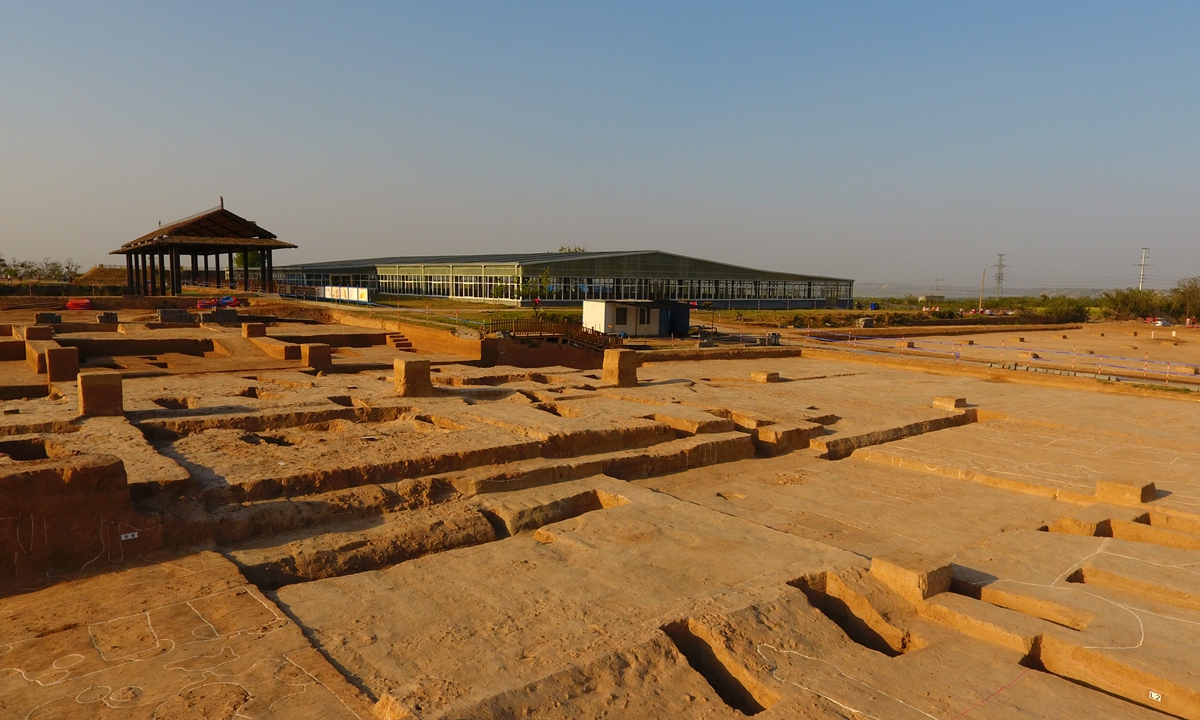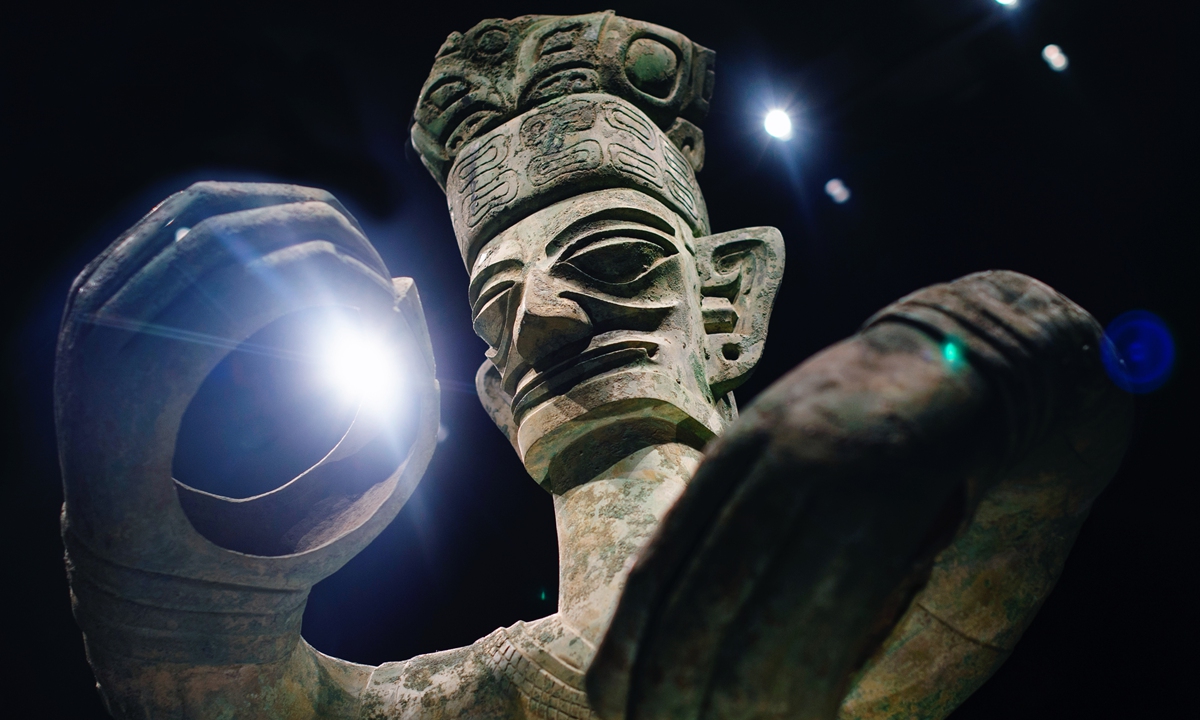
The Shuanghuaishu site Photo: Courtesy of Zhengzhou Municipal Research Institute of Cultural Relics and Archaeology

Bronze Grand Statue of Human Figure Photo: IC
Editor's Note:Chinese President Xi Jinping recently stressed the importance of furthering the study of Chinese civilization to enhance the historical awareness and cultural confidence of the Communist Party of China (CPC) and society, while unswervingly following the path of socialism with Chinese characteristics to realize national rejuvenation.
Xi, also general secretary of the CPC Central Committee, made the remarks during a group study session of the Political Bureau of the CPC Central Committee on a national research program dedicated to tracing the origins of Chinese civilization.
The Global Times spoke with a number of Chinese scholars and experts, so they break down the large-scale program and give readers a detailed and clear view of its accomplishments.
As the chief expert of a national research program dedicated to tracing the origin of Chinese civilization, Wang Wei told the Global Times that the program has achieved fruitful results over the past 20 years. However, he noted that some archaeological mysteries have not yet been solved. As modern Chinese archeology enters its second 100 years, what questions will it be seeking to answer?
Mystery of the Sanxingdui RuinsOne of the greatest archaeological finds of the 20th century, the Sanxingdui Ruins in Southwest China's Sichuan Province, believed to be the remnants of the Shu Kingdom that existed some 4,500 years ago, have stunned archaeologists and history buffs around the world.
As more relics were unearthed, archaeologists came across pits filled with thousands of broken and burnt relics. After this discovery, certain questions plagued experts: Why did the ancient people of the Shu Kingdom destroy these artifacts before carefully burying them in a pit? Where did they attain the ivory, seashells and metal ores used to make these relics? How were they able to carry this out on such a large scale?
Li Haichao, a professor at the School of History and Culture, Sichuan University, told the Global Times that they have launched a program called "Study on Sanxingdui Culture and Chinese Civilization" to solve the above mysteries.
As the chief expert of the program, Li has set up five topics for research: the genealogy, population and social structure of the Sanxingdui Culture, the Sanxingdui Culture's exchanges with other regions, the development of their civilization, the relationship between the region and China's Central Plains and a comparative study that looks at the Sanxingdui Culture and other ancient civilizations at home and abroad.
"I hope that through this project, the collation, research and interpretation of the archaeological excavations at the Sanxingdui Ruins can progress further," said Li.
Discoveries in Heluo KingdomThe Shuanghuaishu site in Central China's Henan Province is also a magical site full of mythological connections, as the site appears to have been a capital during the era of China's Five Legendary Rulers (c. 2600BC-c. 2070BC).
Encompassing an area of some 1.17 million square meters in size, the Shuanghuaishu site is located on the southern bank of the Yellow River in the city of Gongyi's Heluo township.
Since the discovery of the Shuanghuaishu site, many history buffs have expressed a strong curiosity about the site and its relationship with China's Yellow Emperor, one of the Five Legendary Rulers described in many myths.
"The important archaeological findings provide key evidence for further insight into the origin of Chinese civilization and also demonstrates the importance and influence of the Heluo area in the beginning of Chinese civilization around 5,300 years ago," Gu Wanfa, director of the Zhengzhou Municipal Research Institute of Cultural Relics and Archaeology, told the Global Times.
According to Gu, the Shuanghuaishu site is of significant importance for research into the origin of Chinese civilization and still possesses a number of puzzles waiting to be pieced together through archaeology.
For example, in one location at the site nine pottery pots were arranged in the pattern of the constellation Beidou (Big Dipper), which shows that people living in ancient Heluo Kingdom had relatively advanced astronomical knowledge.
Currently, they are verifying whether the location of the Shuanghuaishu site was related to the position of the constellation in the night sky, which would have been different more than 5,000 years ago due to star drift. If this turns out to be the case, it would mean that these ancient people already had the concept of a connection between man and nature, an important concept in later Chinese culture.
Meanwhile, archaeologists have discovered some imprints that look like wheel tracks at the site, but it is still unknown what type of transportation the ancients used.
Other questions such as whether this was the only capital in the region and what relationship these people had with those in other regions also need to be further explored, said Gu.
Looking to the futureConsidering China's over 5,000-year-long history, it is not surprising that so many questions still remain unsolved today.
Jia Xiaobing, a research fellow at the Chinese Academy of Social Sciences' Institute of Archaeology, told the Global Times that archaeologists still need to seek answers concerning regional characteristics and how the interaction of ancient cultures led to the origin of Chinese civilization.
"Future breakthroughs will mainly be achieved through more extensive and in-depth multi-disciplinary cooperation that pushes forward research into the origin of Chinese civilization," said Jia.
Wang echoed that increasing the role various disciplines in the humanities and social sciences play in the study of the origin of civilization is a must.
As modern Chinese archaeology enters its second 100 years, Wang pointed out that increasing international communication and introducing the findings of Chinese archaeology to the world will be an important task.
"In the future, we plan to trace the temporal and spatial scope of this research from 5,500 to 8,000 years ago to about 2,800 years ago. We should let more people understand the excellent Chinese civilization through some immersive experiences or other means of introduction of these archaeological achievements," said Wang.





